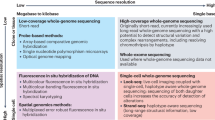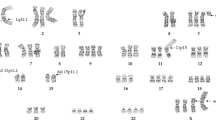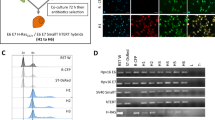Abstract
We have constructed a set of hybrid cell lines by irradiation of GM 64063 (human chromosome 9q only on hamster background) and fusion to hamster A23 Tk−. 109 independent lines were tested by PCR with 24 markers from chromosome 9q. The marker density is highest in the 9q22.3-q31 region containing the gene for Gorlin syndrome, a familial predisposition to basal cell carcinoma. The resolution of our map in this region is significantly higher than other published maps and will enable accurate placing of new markers and genes within the 9q22.3-q3.1 region. This is important since yeast artificial chromosomes from the region are likely to contain deletions.
Similar content being viewed by others
Introduction
Gorlin syndrome (nevoid basal cell carcinoma; NBCCS) is an autosomal dominant predisposition to basal cell carcinoma, palmar and plantar pits and a number of developmental abnormalities with variable penetrance. The gene has been localised to chromosome 9q22.3-q31 [1–3] and efforts to identify this gene by positional cloning are under way in several laboratories. Analysis of rare recombinants and haplotypes in families has defined an interval of approximately 2 cM between D9S196 and D9S180 [4–7], for the mutation and much further progress along these lines is unlikely. Since it is therefore necessary to clone and map a large region, we chose to use radiation hybrids to independently order and localise new markers on a high-resolution physical map.
Radiation hybrids [8–10] are created by lethal irradiation of a donor cell line containing the genetic region of interest usually followed by fusion with a hamster cell line. Fused cell clones are isolated by the selection for a marker present only in the donor cell line. The hybrid cell lines are then tested for retention of markers and a map is constructed by statistical analysis of the cosegregation of the markers. As in genetic linkage, physical distance is related to the frequency of cosegregation assuming random retention of the markers. The resolution and power of the method is determined by the dose of irradiation and therefore the size of the fragments retained in the hybrids, and the number of hybrids analysed with a given number of markers. The donor DNA to be analyzed ranges from short parts of chromosomes containing interesting genes to a whole genome [11].
We have constructed and characterised a panel of radiation hybrids containing fragments of chromosome 9q. We only tested one marker from the distal arm where the locus for tuberous sclerosis (TSC1) is located since high-resolution physical and radiation hybrid maps already exist in that region [12–15]. There are already many markers genetically mapped close to the Gorlin syndrome gene, and a yeast artificial chromosome (YAC) contig of the region has been reported [16]. This contig is, however, significantly smaller than estimates of the region obtained by PGF analysis [Morris and Reis, pers. commun.; Patel and Frischauf, unpubl.]. Since this indicates deletion within the YACs, an independent mapping tool is essential. We have used 24 markers to obtain a high-resolution radiation hybrid map that allows the ordering of markers that are too close to be resolved by genetic analysis, the integration of nonpolymorphic markers into the map and a measure of physical distance independent of YAC clones that may contain deletions or rearrangements.
Materials and Methods
Radiation hybrid cell lines were produced as described [10]. All D9S markers were amplified under conditions as given in GDB. Primers 41 and 42 were used to amplify exon 4 of the XPA gene [17]. All hybrids were typed at least twice with each marker. Only unambiguous typing results were then used in the analysis. The ordering of the chromosome 9q markers was determined by statistical analysis of their co-retention using maximum likelihood methods RHMAP [18].
Results and Discussion
The somatic cell hybrid GM64063 [19] containing the human chromosome 9q on a hamster background was irradiated at 5,000 rad and focused to the TK~ hamster cell line A23 [20]. 120 single colonies were tested by interrepeat PCR for the presence of human material. 109 hybrid cell lines containing human DNA were typed with the 24 PCR markers (see methods).
The retention frequency for the 24 markers varied between 8.3% (D9S179) and 25.7% (XPA) with an average of 18.2%. This is within the range of other published data [21,22]. Since it was not practical to consider all 24!/ 2 orders for the 24 loci analysed, the markers were divided into four lod 3 linkage groups using pairwise maximum likelihood analysis. These groups were consistent with genetic data placing most markers in linkage group 2 in the area of the Gorlin syndrome gene region (9q22.3-q31) and D9S202(FR1), D9S202(MLS1), D9S411E(FD1), D9S166, D9S15 (group 4) near the Friedreichs ataxia locus (9al l-q21). D9S167 (group 3) located between these two groups and D9S179 (group 1) further distal on chromosome 9q are unlinked to the other loci.
Since the focus of our map is the Gorlin gene region, linkage group 2 was analysed in detail. Branch and bound methods were used to order the loci under the assumption that all fragments were retained with equal probability [18]. This analysis proved impractical in acceptable time for the whole group consisting of 17 markers, and the group was further divided into lod 6 linkage groups. The two groups of 12 and 4 markers respectively were analysed separately by calculating the likelihood for all possible permutations and orientations. The best orders are shown in table 1.
D9S155 was excluded from both groups at the lod 6 criterion, consistent with the genetic localization of this marker 13 cM distal to D9S172 [23].
The order obtained by the branch and bound method was confirmed by stepwise methods building an order by adding loci one at a time to all partial orders within lod 6 of the best partial order. The most likely orderings from the stepwise and branch and bound analyses differed only in the placing of marker D9S172. We compared our results to two genetic maps of this region of chromosome 9 [23, 24] neither of which includes all the markers we used. At odds of 1,000:1 Gyapay et al. [23] arrive at the order 197/196-287-176/180-172-155 and Atwood et al. [24] at the order 12-22-109/127-53-172. Marker pairs D9S180/D9S176 and D9S196/D9S197 which were not separated in the genetic map [23] are resolved in the radiation hybrid map. Both results are consistent with a physical map derived by marker analysis of overlapping YAC clones [16]. The order of markers obtained by radiation hybrid mapping is generally consistent with the order derived by genetic analysis. The nonpolymorphix XPA gene is localised between D9S287 and D9S180 in agreement with clone mapping data [16]. The least strongly ordered markers were D9S12 and D9S12II which reside on overlapping cosmids. Marker D9S151 is placed in the interval bounded by D9S197 and D9S119, distal to D9S12. The order cen-D9S12-D9S151 disagrees with map in the chromosome 9 workshop report [12, 13].
The candidate region for the Gorlin gene is flanked proximally by D9S196 and distally by D9S180 [25] at 26 cM. The YAC map of the region containing the markers D9S12 to D9S176 estimates the physical size of the region as less than 1.85 Mb, not taking into account the likely deletions within the YAC clones. Distances on the radiation hybrid map are expressed in centirads (cR), where 1 CR5000 corresponds to a 1% frequency of breakage between two markers after exposure to 5,000 rad of X-rays. Figure 1 shows the most likely order with corresponding distances. A cosmid contig between XPA and D9S180 has been constructed giving a physical distance of 250 kb [Obermayr, unpubl.] corresponding to 43 cR. A ratio of 17 cR/100 kb can be calculated from this result.
In summary, this panel of radiation hybrids will be a useful tool to place new markers reliably into the region of the Gorlin syndrome gene. In particular, nonpolymorphic ESTs have already been assigned to chromosome 9 [26] but need to be localised further on the chromosome. A number of additional ESTs have been mapped to the vicinity of the Gorlin candidate region, but need fine mapping to be regarded as candidate genes [27]. PCR quantities of DNA will be made available. The raw data are also available by e-mail on request (frischau@icrf.ic-net.uk).
References
Gailani MR, Bale SJ, Leffell DJ, di Giovanna JJ, Peck GL, Poliak S, Drum MA, Patakia B, McBnde OW, Kase R, Greene M, Mulvihill JJ, Bale AE: Developmental defects in Gorlin syndrome related to a putative tumor suppressor gene on chromosome 9. Cell 1992:69:111–117.
Farndon PA, Del MR, Evans DG, Kilpatrick MW: Location of gene for Gorlin syndrome. Lancet 1992;339:581–582
Reis A, Kuester W, Linss G, Gebel E, Hamm H, Fuhrmann W, Wolff G, Groth W, Gustafson G, Kuklik M, Buerger J, Wegner R, Neitzel H: Localisation of gene for the naevoid basalcell carcinoma syndrome. Lancet 1992:339: 617.
Chanevix TG, Wicking C, Berkman J, Sharpe H, Hockey A, Haan E, Oley C, Ravine D, Turner A, Goldgar D, Searle J, Wainwright B: Further localization of the gene for nevoid basal cell carcinoma syndrome (NBCCS) in 15 Australasian families: Linkage and loss of heterozygosity. Am J Hum Genet 1993;53:760–767
Compton JG, Goldstein AM, Turner M, Bale AE, Kearas KS, McBnde OW, Bale SJ: Fine mapping of the locus for nevoid basal-cell carcinoma syndrome on chromosome 9q. J Invest Dermatol 1994;103:178–181
Farndon PA, Morris DJ, Hardy C, McConville CM, Weissenbach J, Kilpatrick MW, Reis A: Analysis of 133 meioses places the genes for nevoid basal-cell carcinoma (Gorlin)-syn-drome and Fanconi-anemia group C in a 2.6cM interval contributes to the fine map of 9q22.3. Genomics 1994;23:486–489
Goldstein AM, Stewart C, Bale AE, Bale SJ, Dean M: Localization of the gene for the nevoid basal-cell carcinoma syndrome. Am J Hum Genet 1994;54:765–773
Cox DR, Bormeister M, Price ER, Kim S, Myers RM: Radiation hybrid mapping: A somatic cell genetic method for constructing high-resolution maps of mammalian chromosomes. Science 1990;250:245–250
Goss SJ, Harris H: New method for mapping genes in human chromosomes. Nature 1975;255:680–683
Walter MA, Goodfellow PN: Radiation hybrids — irradiation and fusion gene-transfer. Trends Genet 1993;9:352–356
Walter MA, Spillett DJ, Thomas P, Weissenbach J, Goodfellow PN: A method for constructing radiation hybrid maps of whole genomes. Nat Genet 1994;7:22–28
Pericak-Vance MA, Bale AE, Haines JL, Kwiatowski DJ, Pilz A, Slaugenhaupt TS, White JA, Edwards J, Marchuk D, Povey S: Report on the Fourth International Workshop on Chromosome 9. Ann Hum Genet 1995;59:347–391
Povey S, Armour J, Farndon P, Haines JL, Knowles M, Olopade F, Pilz A, White JA, Kwiatowski DJ: Report on the 3rd International Workshop on Chromosome 9 and on Tuberous Sclerosis held at Queen’s College, Cambridge, April 1994. Ann Hum Genet 1994;58:177–200
Harris RM, Carter NP, Griffiths B, Goudie D, Hampson RM, Yates JRW, Affara NA, Fergusonsmith MA: Physical mapping within the tuberous sclerosis linkage group in region 9q32-q34. Genomics 1993;15:265–274
Florian F, Hornigold N, Griffin DK, Delhanty JD, Sefton L, Abbott C, Jones C, Goodfellow PN, Wolfe J: The use of irradiation and fusion gene-transfer (IFGT) hybrids to isolate DNA clones from human-chromosome region 9q33-q34. Somat Cell Mol Genet 1991;17:445–453
Morris DJ, Reis A: A YAC contig spanning the nevoid basal cell carcinoma syndrome, Fanconi anemia group C, and xeroderma pigmentosum group A loci on chromosome 9q. Genomics 1994;23:23–29
Satokata I, Tanaka K, Miura N, Miyamota I, Satoh Y, Kondo S, Okada Y: Characterization of a splicing mutation in group A xeroderma pigmentosum. Proc Natl Acad Sei USA 1990;87:9908–9912
Boehnke M, Lange K, Cox DR: Statistical methods for multipoint radiation hybrid mapping. Am J Hum Genet 1991;49:1174–1188
Jones C, Kao FT: Regional mapping of the folylpolyglutamate synthetase gene (FPGS) to 9cen-q34. Cytogenet Cell Genet 1984;37.
Westerveld A Visser RPLS, Khan PM, Bootsma D: Loss of human genetic markers in man-Chinese hamster ovary cells. Nature New Biol 1971;234:20–22
Fraser KA, Boehnke M, Budarf ML, Wolff RK, Emanuel BS, Myers RM, Cox DR: A radiation hybrid map of the region on human chromosome 22 containing the neurofibromatosis type 2 locus. Genomics 1992;14:574–584
Richard CW, Boehnke M, Berg DJ, Lichy JH, Meeker TC, Hauser E, Myers RM, Cox DR: A radiation hybrid map of the distal short arm of human chromosome 11 containing the Beck-with-Weidemann and associated embryonal tumor disease loci. Am J Hum Genet 1993;52:915–921
Gyapay G, Morissette J, Vignal A, Dib C, Fizames C, Millasseau P, Marc S, Bernardi G, Lathrop M, Weissenbach J: The 1993–94 genethon human genetic-linkage map. Nat Genet 1994;7:246–339
Attwood J, Chiano M, Collins A, Doniskeller H, Dracopoli N, Fountain J, Falk C, Goudie D, Gusella J, Haines J: CEPH consortium map of chromosome 9. Genomics 1994;19:203–214
Wicking C, Berkman J, Wainwright B, Chenevixtrench G: Fine genetic-mapping of the gene for nevoid basal-cell carcinoma syndrome. Genomics 1994;22:505–511
Auffray C, Behar G, Bois F, Bouchier C, Da Silva C, Devignes MD, Duprat S, Houlgatte R, Jumeau MN, Lamy B, Lorenzo F, Mitchell H, Mariage-Samson R, Pietu G, Pouliot Y, Sebasiani-Kabaktchis C, Tessier A: IMAGE: Molecular integration of the analysis of the human genome and its expression. C R Acad Sci III 1995;318:263–272
Hudson TJ, Stein LD, Gerety SS, Ma JL, Castle AB, Silva J, Slonim DK, Baptista R, Kruglyak L, Xu SH, Hu XT, Colbert AME, Rosenberg C, Reevedaly MP, Rozen S, Hui L, Wu XY, Vestergaard C, Wilson KM, Bae JS, Maitra S, Ganiatsas S, Evans CA, Deangelis MM, Ingalls KA, Nahf RW, Horton LT: An STS-based map of the human genome. Science 1995;270:1945–1954
Dib C, Faure S, Fizames C, Samson D, Drouot N, Vignal A, Millasseau P, Parc S, Hazan J, Seboun E, Lathrop M, Gyapay G, Morissette J, Weissenbach J: A comprehensive genetic-map of the human genome based on 5,264 microsatellites. Nature 1996;380:152–154
Acknowledgements
This work was funded by the Imperial Cancer Research Fund and by a HGMP grant of the MR to P.N.G. We thank Alan Leung and Kylie Negus for help in characterising the hybrids and B. Wainwright and C. Wicking for helpful discussions.
Author information
Authors and Affiliations
Rights and permissions
About this article
Cite this article
Obermayr, F., Walter, M.A., Jones, H.B. et al. A High-Resolution Radiation Hybrid Map of the Region Surrounding the Gorlin Syndrome Gene. Eur J Hum Genet 4, 242–245 (1996). https://doi.org/10.1159/000472206
Received:
Revised:
Accepted:
Issue Date:
DOI: https://doi.org/10.1159/000472206




